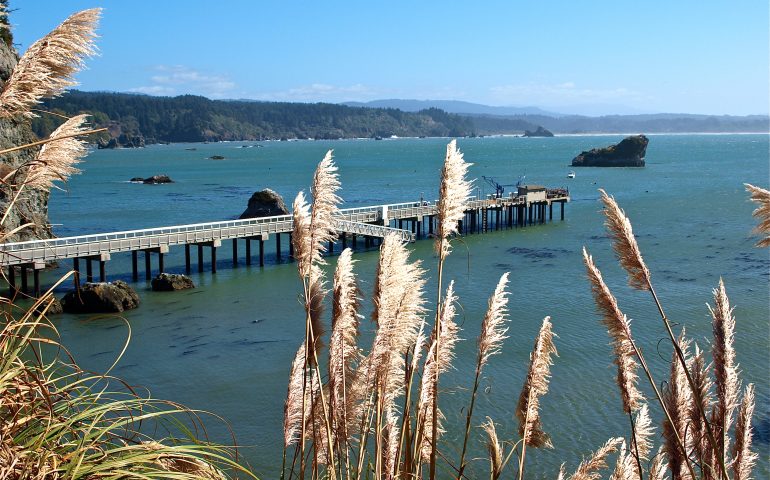This is also one of the few piers (in California) where you may occasionally catch one of the red or orange-colored rockfish. Small-to-medium-size orange (canary) rockfish (Sebastes pinniger) and even rosy rockfish (Sebastes rosaceus) have been caught off the end of the pier. However, remember that orange rockfish are now illegal so if you do hook one be sure to carefully release it. Both black rockfish (here called black snappers or kelp bass) and blue rockfish are more common and frequently schools will show up by the pier; when that happens the lucky anglers will be assured a bucketful of the fish. A few small yellowtail rockfish may also be caught; be sure to return them to the water if undersized.
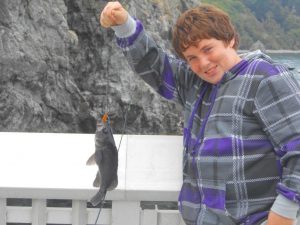
Hans Jones Junior with a black rockfish
Although I have heard of few salmon being taken from the pier, they are occasionally seen in the sandy beach area. Best time to try for them should be July to September and your best bet would be to try using an anchovy under a float or large bobber. Another pelagic species, although rare except during warm-water El Nino years is Pacific mackerel, one of which was caught during our UPSAC Kids Fishing Derby in 2014.
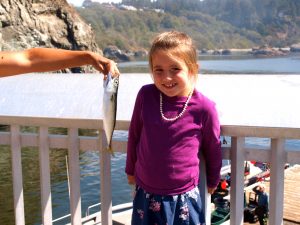
Pacific mackerel
As mentioned a few wolf eels also show up. One day I got a note from Dsrtegl, a PFIC regular who said: “wolf eels are fun until you try to take them off the hook. I had one crush a steel-toed Redwing boot on my foot one time… it was a 6 1/2 footer caught off Trinidad Pier. I ended up having to kill the eel to get the bloody thing to let go of my foot. Not my best day.” Apparently it was the same for the eel.
Crustaceans. For crabs, and usually here we’re talking rock crabs, drop a hoop net mid-pier out toward the shed. Use the traditional fish head, squid, or chicken necks for bait, and be prepared to catch a least a few of the tasty crustaceans.
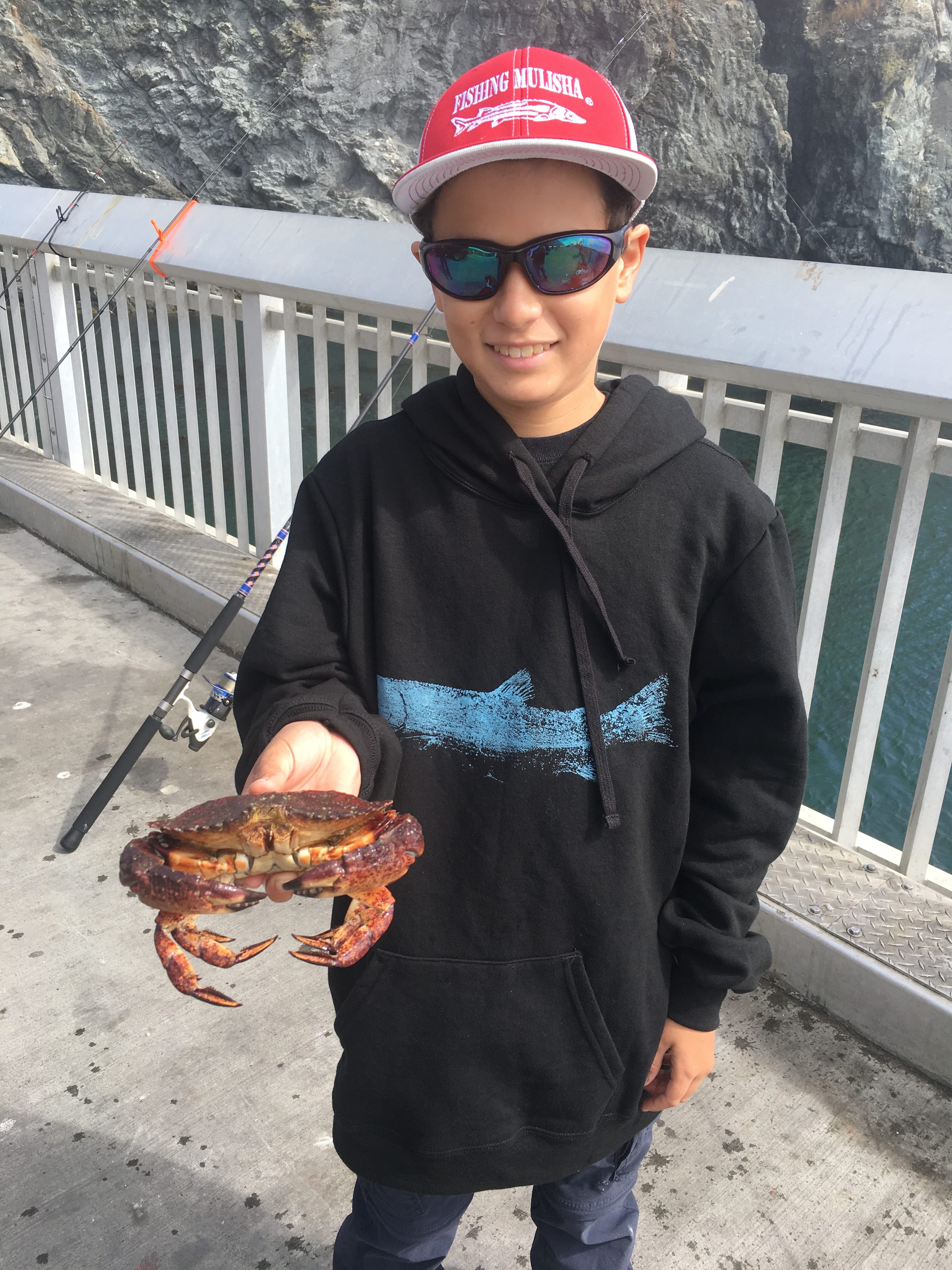
Don’t be surprised if a crab grabs hold of the bait on your line — and doesn’t let go.
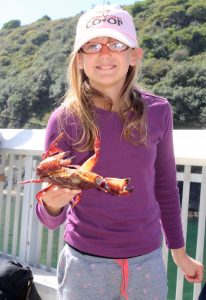
I caught a crab!
Notes. The new pier is beautiful but flawed for pier anglers in several ways (1-3) and it also can call for some special attention (4-6).
(1) The railings are not designed for holding rods; they are aluminum and slanted. Lean your rod against the railing and sooner or later it’s going to slide to the ground. An easy way to prevent this is to tie a couple of towels (or a couple of bungee cords) to the railing and put your rod between the towels/cords.
(2) There are no bait cutting boards so bring your own. Small plastic cutting boards are easy to find and inexpensive. I always say to try to leave a pier cleaner than you found it and leaving mucky fish guts and blood on the pier will win you few friends.
(3) The pier lacks fish cleaning facilities. That means you will need to take the fish you catch somewhere else to clean them. I usually try to leave some room in my bait cooler for the fish I catch. If too many fish are caught for the bait cooler, or they’re too big, I haul them back to my car where I usually have a larger cooler and ice.
(4) Always bring warm clothing to this pier. Summertime temperatures rarely rise above 65-70 degrees, the wind can be ferocious at almost any time of the year, summer fog is a definite likelihood, and wintertime storms can knock out any hopes of fishing. Best bet for good weather is in the fall when it is sometimes almost balmy but you should still bring a jacket.
(5) Although it sounds a little unusual, you might want to bring bug spray with you, the type intended to keep bugs off of you. My last couple of trips to the pier saw huge numbers of flies (kelp flies I believe) and they can be VERY annoying.
(6) Lastly, recognize the fact that pier fishing is of secondary importance to the commercial fishing and boat sport fishing. No one really minds if you fish from the pier but stay out of the way and don’t interfere with the customers who make money for the pier operator. And, do clean up after yourself including leaving no trash.
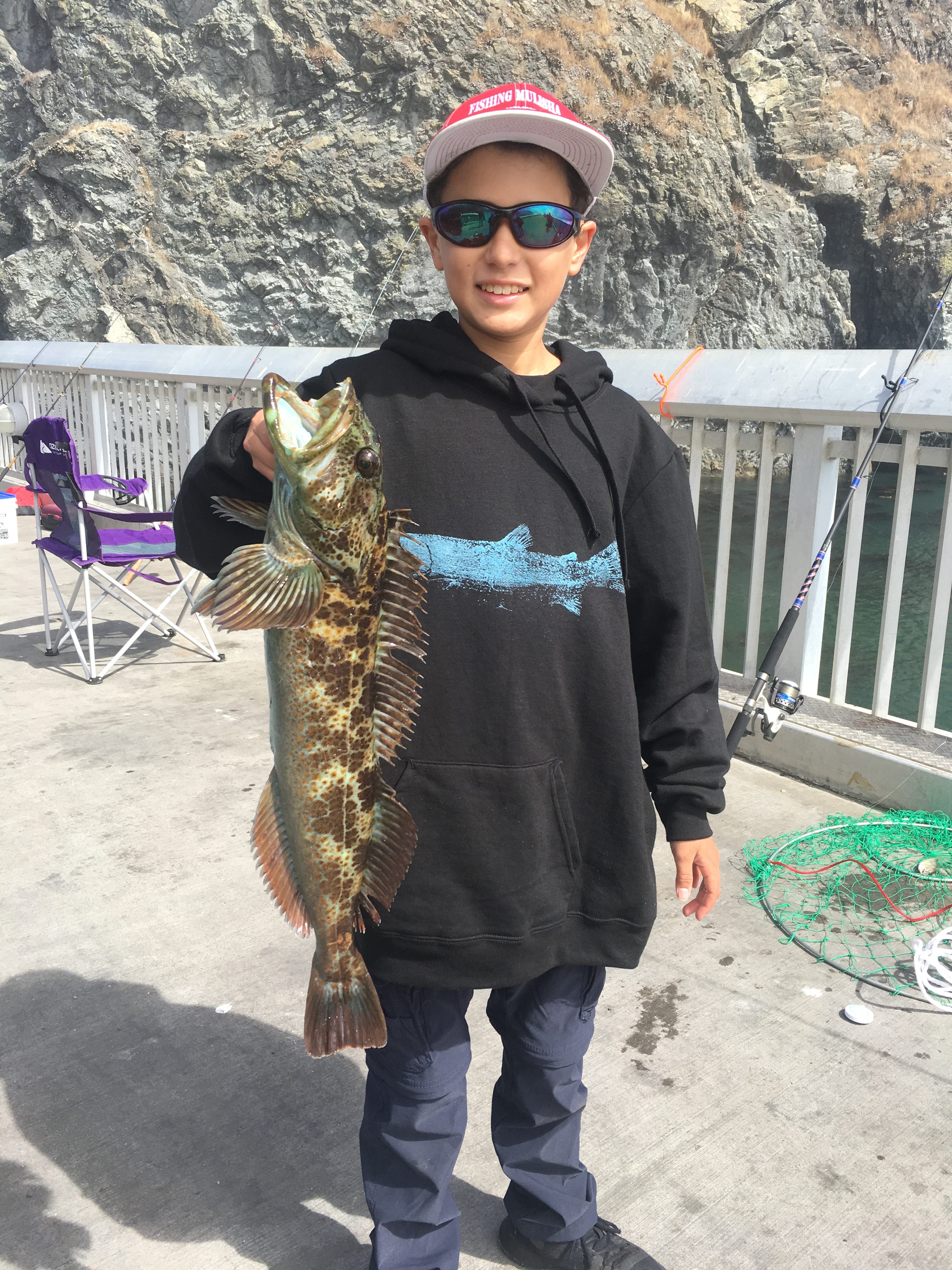
Legal-size lingcod taken by David Shigematsu in 2018 on a live shinerperch
Potpourri — Perhaps More Than You Wanted To Know About The Trinidad Pier
<*}}}}}}}}}>< — Did you hear the one about Rosie and The Creature From The Black Lagoon? I did! The story’s main characters were Rosie, who used to work at Salty’s Bait and Tackle in Trinidad, and an unidentified creature that fell in love with our heroine. Well, not exactly! That might be a slight stretch. The actual incident took place during the summer of 1996 when Rosie decided to get in a couple of hours of late afternoon fishing down at the picturesque old pier in Trinidad Harbor. She was using an Abu-Garcia outfit loaded with 20-pound test line, and for bait she had brought along some herring. Maybe a salmon would grab her bait.
Rosie cast her bait out to the waters on the north side of the pier and began to wait for a strike. When it came, she was in the fight of her life. Something grabbed the bait and took off on the start of a long, long fight. Rosie was soon joined by friends and onlookers who shortly thereafter dubbed her unseen foe, “The Creature From The Black Lagoon.”
It actually wasn’t anything quite so exotic but you never know until you see your quarry. Eventually she did see the fish, a large 100+ pound big skate (and a name was never more appropriate) that measured 4 ½’ wide and 5 ½’ long.
It took Rosie, and several of her friends, 45 minutes to land the obstinate critter that apparently did not want to end up in Rosie’s kitchen (but it did). It may have been, in fact probably was, the largest fish ever landed from the pier. Although local boaters have brought in some huge salmon, lingcod, and Pacific halibut, I doubt if any was as hard to land as Rosie’s big skate. Keeping the fish out of the rocks and kelp that surround the pier, as well as keeping it out of the pilings, had to be a combination of Herculean skill combined with a good amount of luck.
<*}}}}}}}}}>< — “Smelt rule!” That would seem to be the case based upon a study of fish collected in Trinidad Bay in 1993-94 (Mulligan and Mulligan). Numerically the top dozen species out of the 32 species collected were (in order)—surf smelt, shinerperch, topsmelt, night smelt, calico surfperch, speckled sanddab, striped seaperch, black rockfish, sand sole, slimy snailfish, spotfin surfperch, and walleye surfperch. Surf smelt, topsmelt and night smelt made up 68% of the total number of fish. These fish were captured at two surf sites and help explain why I recommend fishing by the rocks adjacent to the pier instead of casting toward the surf of Pier Beach. After all, which would you prefer, surf smelt or cabezon?
<*}}}}}}}}}>< — Studies reported in 1965 (Miller and Gotshall) painted a somewhat different picture in regards to smelt ruling the roost. Their study, in DF&G Fish Bulletin 130, took a look at the fish actually caught from the pier and compared results of sixteen piers between Pismo Beach and Trinidad. The catch per day average at Trinidad was the lowest of all the piers surveyed, averaging less than one fish per day. Nevertheless, it did show the capture of 21 different species and showed the pier being #1 in regard to kelp greenling, brown Irish lord, buffalo sculpin and wolf-eel. The results were to be somewhat expected given the rocky environment of the pier.
The top ten species taken from the pier were: (1) kelp greenling; (2) walleye surfperch; (3) striped seaperch; (4) silver surfperch; (5) black rockfish; (6) redtail surfperch; (7) cabezon; (8) buffalo sculpin, (9) Pacific tomcod; (10) rock greenling.
Fish and Game surveys done roughly forty years later, from 2004-2009, showed nine different fish species being taken from the pier with striped seaperch leading the list followed by kelp greenling (which actually showed up more years than striped seaperch), walleye surfperch, shinerperch, redtail surfperch, calico surfperch, black rockfish, grass rockfish and pileperch.
<*}}}}}}}}}>< — The first fish I caught at Trinidad, during my first visit in 1976, was a kelp greenling. It happened to also be the first fish that I had caught of the species. And, to this day, kelp greenling continue to rank #1 when it comes to the number of fish I have caught from the pier (followed by black rockfish, rock greenling and striped seaperch). I think it’s reasonable to say that the Trinidad Pier is the top pier in the state for kelp greenling.
The greenlings, both kelp and rock, present an unusual problem as far as the regulations. When I am fishing, I am rarely targeting just one species. As example, when I am fishing the rocky area at Trinidad I am targeting several different species—kelp greenling, cabezon, rock greenling, black rockfish and striped seaperch. It’s the same with most anglers, they cast the bait out and hope a fish (any fish, any species) hits the bait.
However, greenlings fall into a special classification under the Northern Groundfish Management Area rules. These rules, both federal and state, limit the catch of greenlings to ten fish and set a minimum size length of 12 inches. Luckily, while the season for boaters (all types) is limited to May 15 through October 31 (in waters shallower than 20 fathoms) the rules allow year round fishing from piers.
Specifically, section 27.25(2) states, “when angling from shore (includes beaches, banks, piers, jetties, breakwaters, docks, and other man-made structures connected to shore, all species may be taken or possessed year-round.”
Nevertheless, a troubling caveat is found in section 28.29(d): Method of take, “When angling, gear is restricted to no more than two hooks and one line.” Thus you are not to take greenling with more than one line in the water.
Public piers always restrict anglers to two rods because a license is not required. Private piers require a license but do not have a restriction of rods unless it is a local pier restriction. At Trinidad, a private pier, I have always in the past recommended using two rods, one for the rocky area and one for the sandy-bottom area out away from the pier.
However, given the groundfish regulations on greenling, this would seem to be illegal. If specifically fishing in the rocky area for greenling, the number one fish here, you can only use one rod.
I believe a person could still use two rods if they were primarily fishing the west side area by the sand or the end area. I say this since all of the greenling I have taken from the pier have been caught in the inner rocky section of the pier. Nevertheless, it’s an interesting conundrum for the pier, its anglers, and even the Fish and Wildlife wardens. The rule regarding one rod was intended to reflect fishing from a boat, not from a pier or shore, but seems to gather up the latter in its web of rules.
<*}}}}}}}}}>< — The California state record grass rockfish, a fish weighing 5 lb, 6 oz, was caught at Trinidad on July 14, 2006.
<*}}}}}}}}}>< — Be sure to watch for the otters in the bay. There are quite a few of the playful beasts and they can be quite comical at times. One day I watched a pair that was checking out the skiffs tied down below the pier. They had no trouble getting into the boats and went down the line entering one boat after another. I wondered if they were looking for bait (food) left by the fishermen. As I watched, I also began to think they looked like big rats even though that doesn’t fit the normal stereotype of the species. I was curious as to whether or not they hurt the fishing at the pier.
Tyler Epting answered my question about the otters: “The ‘sea otters’ that you saw in and around the pier are actually a local band of river otters, probably from Little River, that have taken to the sea. Hence their resemblance to ‘rats.’ This is actually more common than most people realize, and it probably does affect the fishing, as river otters are piscivorous (eat fish), as opposed to their mollusk loving cousins, the sea otter. Here’s a funny story. I was fishing the lower boat dock at Trinidad one day, and I had what I thought was a large lingcod drag my live perch very slowly under the dock. When I went to set the hook, I quickly realized that my line was snagged on something directly underneath the dock and very stationary. Right away I began to hear a chomping sound behind me, and I turned around to see a very happy otter chewing away at my perch. After the otter had finished his meal, he plopped back into the water. Further investigation found my hook firmly embedded in the side of the dock.”
